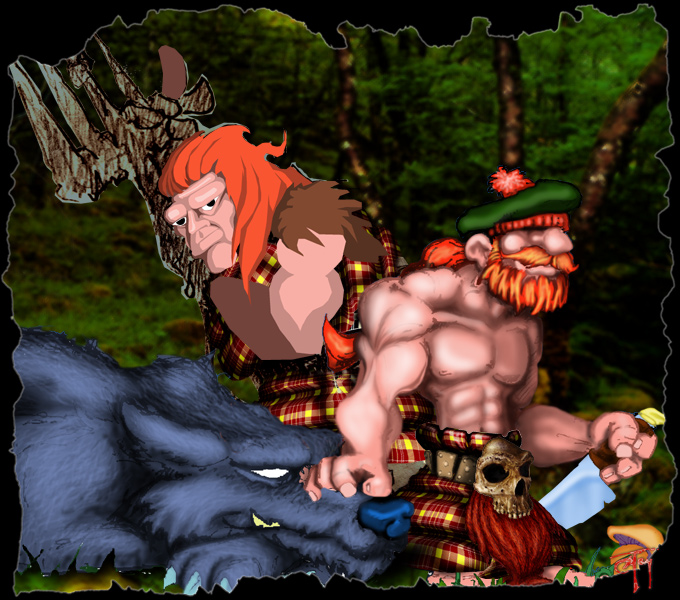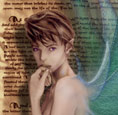The
Legend of Sawney Beane
"Go ye not by Gallowa
Come bide a while, my frein
I'll tell ye o the dangers there
Beware o Sawney Beane."
Notes
on the life and times of VerSache the Barbarian :
Ex
libris necessarius VerSache
obscurus barbarus :
This extraordinary collection
offers striking insight
into the historical VerSache the Barbarian.
Compiled, Photographed,
Edited, Rebound and Translated
by Marjorie Chillblaine
:
Today the most ancient
of the original documents
exist beginning with
600 leaves (or
folios) made
from hemp, Some folios
are of single sheets,
most are twice the width,
then folded to accommodate
2 pages of text, The
decorated pages often
occurred on single sheets.
The folios had lines
drawn for the text, sometimes
on both sides. Prick
marks and guide lines
can still be seen on
some pages. The hemp
is of high quality, although
the folios have an uneven
thickness, with some
being almost leather,
while others are so thin
as to be almost translucent.
Food, beer and coffee
stains abound throughout
...
Sometime
in the early 15th century, during the reign of James I of
Scotland (1406-37), or as some accounts assert,
under the rule of James IV (1488-1513)
Alexander 'Sawney' Beane was born in East Lothian near Edinburgh,
little is mentioned of his youth save he was said to be lazy, cunning,
vicious, and resentful of authority of any kind. To avoid earning
an honest living on the family farm, he ran off to seek his fortune,
taking his woman (quaintly named 'Black' Agnes Douglas by
one account) with him. The two of them soon set up camp in
a deep cave which was situated close to Ballantrae, on what is now
the Ayrshire coast, near Galloway.
This cave was said to penetrate more than 2 kilometres into the earth,
with many twisting passageways, and unexplored tunnels leading off
into Stygian depths. Twice a day at high tide several hundred metres
of the cave's entrance passage was flooded, which formed a natural
deterrent to unwanted intruders. For some time the pair made their
living as bandits, slaying all their victims. As folk in that part
of Scotland were not wont to carry great sums of coin on their persons
and meals being scarce, the couple decided that they need not buy
meat at all, choosing rather to consume the evidence of their grisly
crimes. After dissection the limbs and edible cuts were dried, salted
and pickled, and hung on improvised hooks around the walls of the
cave (the bones were stacked in another part of the
cave system), creating a larder of human meat on which
they were to survive, indeed thrive, for more than a quarter of a
century.
As you do, Sawney and 'Black' Agnes starting procreating, producing
fourteen children in all, who in turn gave rise to a second generation
of eight grandsons and fourteen granddaughters, by incestuous
means. This inbred horde murdered travellers on lonely roads
by day or night, yet members of the Beane clan were never suspected
when they ventured from their Lair into nearby towns and hamlets.
The children reached adulthood, growing well-versed in the art
of ambush, murder, and cannibalistic butchery. For years they
continued, growing older, more savage, and less human in most
respects.
Twenty-five years passed, with scarcely a clue—other than
an occasional piece of dodgy pickled human flesh, being found
on the sea-strand or elsewhere—as to what was going on.
Cannibalism was at last suspected, and searches of the countryside
were made. Many were wrongly accused of the crimes and suspicion
especially fell on local innkeepers, since they were often the
last to see many of the missing men and women alive. It has been
estimated that over a thousand people died at the hands of Beane
and his family. Finally, their descent into depravity was revealed.
One night a band of Beanes waylaid a man and woman who were passing
near their domain. The Beane females fell upon the unfortunate
woman like animals, cutting her throat and sucking at the bloody
wound even as she died. They also disemboweled her on the spot
and began to feast upon her organs before the eyes of her embattled
and horrified husband who, as it happened, proved to be a surprisingly
effective opponent, managing to hold off the entire family for
quite some time with nothing but his sword and deft control of
his horse. The sudden appearance of a band of twenty or more
riders coming home from the local fair frightened the Beanes
away and so the husband escaped their clutches. They had attempted
to drag his wife's body toward their lair, but had abandoned
it some distance away, and the man showed this to the riders
and told his tale. He was taken to Glasgow where he made his
report to the authorities, and after a few days the King himself
arrived on the scene, accompanied by four hundred soldiers.
At first the company passed by the low-entranced cave, searching
for tracks along the strand; but the numerous bloodhounds they'd
brought along had a different idea, and set to howling and barking
at the cavern entrance. The soldiers fetched torches and entered
the black den. As they descended, they beheld a horrid spectacle
that could have come from the most hellish myth: the bodies of
men, women, and children, dismembered and hung up to cure; their
limbs pickled and in stacks; and a tremendous amount of stolen
wealth, a treasure-trove accumulated over the years. Eventually
they came into the living quarters of the Beanes themselves.
There was a standoff, but at last the cannibals surrendered and
were taken captive.
The king had them marched in chains to Edinburgh, but they had
no trial. They were then taken to Leith for execution. The men
were dismembered, their arms and legs cut off while they were
still alive and conscious, and they were left to bleed to death,
watched by their women. The women were burned in great fires,
by all accounts screaming curses and blasphemies to the very
end.





